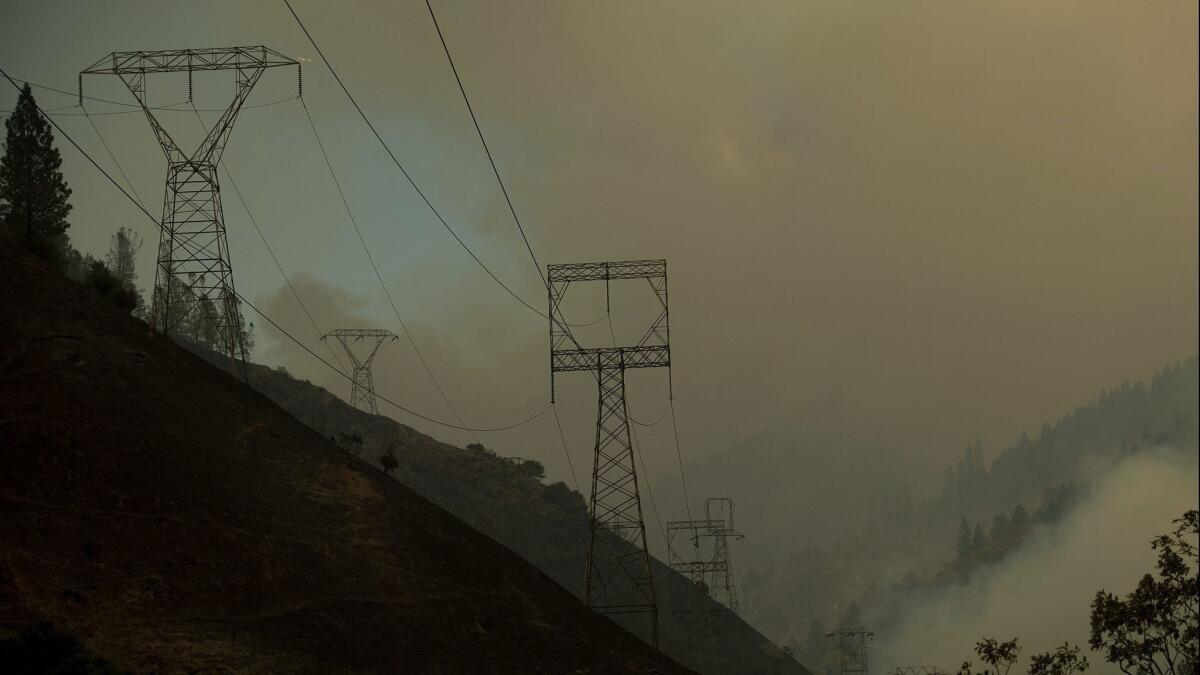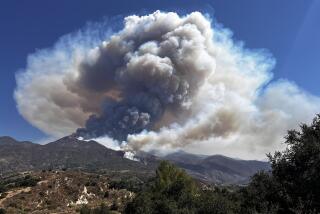Editorial: How do we prepare for California’s ‘new abnormal’ wildfire risk?

It’s going to be a while before California Department of Forestry and Fire Protection investigators determine what sparked the Camp fire in Northern California foothills near Chico — maybe a long while. But there’s a good possibility the high-voltage power lines operated by Pacific Gas & Electric that malfunctioned shortly before the fire began are at fault.
Power lines may have also sparked the Woolsey fire in Southern California. Just two minutes before the blaze that has so far charred 100,000 acres and about 1,500 structures was reported near the shuttered Santa Susana Field Lab on Nov. 8, power lines nearby also went offline. Whether the outage caused the fire or vice versa is still unknown.
But considering the recent past, it may well turn out that the power lines were damaged by intense winds, causing them to spit sparks that ignited surrounding brush. After all, power lines were at fault in other recent wildfires — the Thomas fire in December that scorched 440 square miles in Ventura and Santa Barbara counties and more than a dozen fires that collectively ravaged California’s wine country last fall.
Should the state require a higher standard for electrical infrastructure if and when fire-ravaged communities rebuild?
This can’t keep happening. Though power lines have sparked fires for as long as the lines have existed, in recent years they have become a major threat as climate change-driven conditions — what Gov. Jerry Brown calls the “new abnormal” for California — have converged with human development in high fire risk terrain. If this terrifying trend continues, it will jeopardize not just lives and landscapes, but the existence of the electrical utilities that most Californians rely on to power their homes.
State law requires utilities to pay for damage to private property when their equipment starts a wildfire, whether or not there was negligence involved. With wildfires causing billions of dollars of damage, the threat of liability has led all three of the state’s big investor-owned electrical utilities — PG&E, Southern California Edison and San Diego Gas & Electric — to warn that fire costs could bankrupt them.
Earlier this year lawmakers passed SB 901, the product of months of work by a joint conference committee on wildfires. It contained some good elements, such as new fire prevention requirements for utilities, many of which are already being implemented. The primary focus of the bill, however, was on easing the financial burden for the investor-owned utilities.
The measure left utilities strictly liable for fire damages caused by their equipment, but allowed regulators to shift those costs to ratepayers when utilities were not negligent. That relief might keep the utilities that power our homes from going belly up if they did nothing wrong, but it won’t give utilities any greater incentive to prevent fires.
There’s much more to do when it comes to preventing wildfires, as this month’s firestorms illustrate. And that’s why lawmakers must start considering what comes next.
Enter the Fray: First takes on the news of the minute from L.A. Times Opinion »
Do we need stricter rules for when power must be cut off to prevent sparking a fire, particularly for high-voltage transmission lines such as the one that malfunctioned just before the Camp fire ignited? What about requiring power lines to be moved underground instead of being strung from poles, where they can be snapped by high winds? Admittedly, buried lines are expensive and can be prone to flooding and earthquake damage. But the cost might be worth it in some high fire risk areas.
Should the state require a higher standard for electrical infrastructure if and when fire-ravaged communities rebuild? Or do we upend the current utility model altogether? One state senator is considering legislation to break up the state’s investor-owned utilities or make them public. That’s an extreme option, and it’s not clear how the change would lower fire risks. But with such an existential threat facing the state, everything should be up for discussion.
The future of PG&E, which powers much of Northern California, is a more immediate question. The company, already on the hook for 17 fires last year, said last week that it doesn’t have enough insurance to cover payouts if it is found to be liable for the Camp fire. The California Public Utilities Commission announced last week that it would be taking the unusual step of examining PG&E’s governance structure as part of a safety culture probe, and may even consider recommending a breakup of the massive utility. While the PUC looks for answers, the rest of the state’s leaders must grapple with the link between power lines and fires as well. This issue needs to be a top priority if Brown’s “new abnormal” is indeed the state’s future.
Follow the Opinion section on Twitter @latimesopinion and Facebook
More to Read
A cure for the common opinion
Get thought-provoking perspectives with our weekly newsletter.
You may occasionally receive promotional content from the Los Angeles Times.










